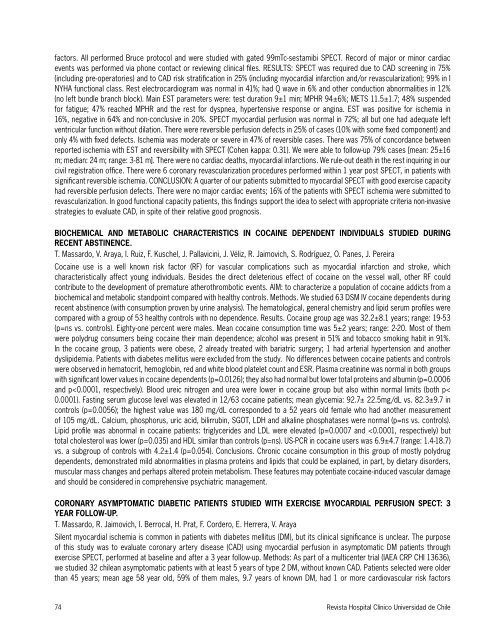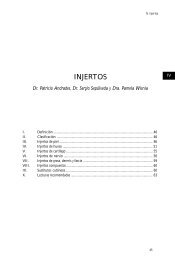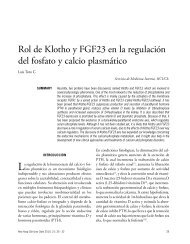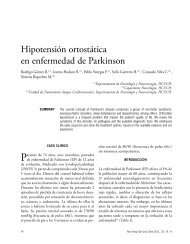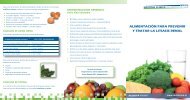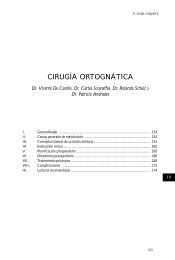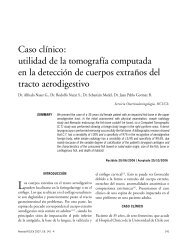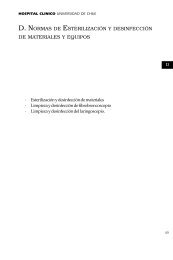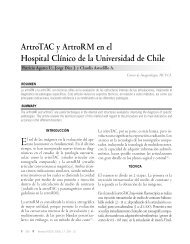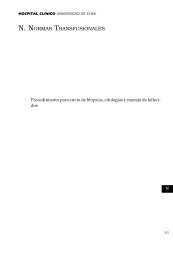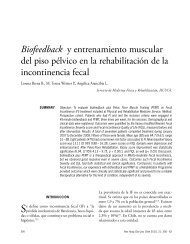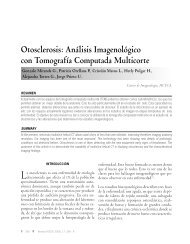Abstracts de trabajos presentados en congresos internacionales 2012
Abstracts de trabajos presentados en congresos internacionales 2012
Abstracts de trabajos presentados en congresos internacionales 2012
Create successful ePaper yourself
Turn your PDF publications into a flip-book with our unique Google optimized e-Paper software.
factors. All performed Bruce protocol and were studied with gated 99mTc-sestamibi SPECT. Record of major or minor cardiacev<strong>en</strong>ts was performed via phone contact or reviewing clinical files. RESULTS: SPECT was required due to CAD scre<strong>en</strong>ing in 75%(including pre-operatories) and to CAD risk stratification in 25% (including myocardial infarction and/or revascularization); 99% in INYHA functional class. Rest electrocardiogram was normal in 41%; had Q wave in 6% and other conduction abnormalities in 12%(no left bundle branch block). Main EST parameters were: test duration 9±1 min; MPHR 94±6%; METS 11.5±1.7; 48% susp<strong>en</strong><strong>de</strong>dfor fatigue; 47% reached MPHR and the rest for dyspnea, hypert<strong>en</strong>sive response or angina. EST was positive for ischemia in16%, negative in 64% and non-conclusive in 20%. SPECT myocardial perfusion was normal in 72%; all but one had a<strong>de</strong>quate leftv<strong>en</strong>tricular function without dilation. There were reversible perfusion <strong>de</strong>fects in 25% of cases (10% with some fixed compon<strong>en</strong>t) andonly 4% with fixed <strong>de</strong>fects. Ischemia was mo<strong>de</strong>rate or severe in 47% of reversible cases. There was 75% of concordance betwe<strong>en</strong>reported ischemia with EST and reversibility with SPECT (Coh<strong>en</strong> kappa: 0.31). We were able to follow-up 79% cases [mean: 25±16m; median: 24 m; range: 3-81 m]. There were no cardiac <strong>de</strong>aths, myocardial infarctions. We rule-out <strong>de</strong>ath in the rest inquiring in ourcivil registration office. There were 6 coronary revascularization procedures performed within 1 year post SPECT, in pati<strong>en</strong>ts withsignificant reversible ischemia. CONCLUSION: A quarter of our pati<strong>en</strong>ts submitted to myocardial SPECT with good exercise capacityhad reversible perfusion <strong>de</strong>fects. There were no major cardiac ev<strong>en</strong>ts; 16% of the pati<strong>en</strong>ts with SPECT ischemia were submitted torevascularization. In good functional capacity pati<strong>en</strong>ts, this findings support the i<strong>de</strong>a to select with appropriate criteria non-invasivestrategies to evaluate CAD, in spite of their relative good prognosis.BIOCHEMICAL AND METABOLIC CHARACTERISTICS IN COCAINE DEPENDENT INDIVIDUALS STUDIED DURINGRECENT ABSTINENCE.T. Massardo, V. Araya, I. Ruiz, F. Kuschel, J. Pallavicini, J. Véliz, R. Jaimovich, S. Rodríguez, O. Panes, J. PereiraCocaine use is a well known risk factor (RF) for vascular complications such as myocardial infarction and stroke, whichcharacteristically affect young individuals. Besi<strong>de</strong>s the direct <strong>de</strong>leterious effect of cocaine on the vessel wall, other RF couldcontribute to the <strong>de</strong>velopm<strong>en</strong>t of premature atherothrombotic ev<strong>en</strong>ts. AIM: to characterize a population of cocaine addicts from abiochemical and metabolic standpoint compared with healthy controls. Methods. We studied 63 DSM IV cocaine <strong>de</strong>p<strong>en</strong><strong>de</strong>nts duringrec<strong>en</strong>t abstin<strong>en</strong>ce (with consumption prov<strong>en</strong> by urine analysis). The hematological, g<strong>en</strong>eral chemistry and lipid serum profiles werecompared with a group of 53 healthy controls with no <strong>de</strong>p<strong>en</strong><strong>de</strong>nce. Results. Cocaine group age was 32.2±8.1 years; range: 19-53(p=ns vs. controls). Eighty-one perc<strong>en</strong>t were males. Mean cocaine consumption time was 5±2 years; range: 2-20. Most of themwere polydrug consumers being cocaine their main <strong>de</strong>p<strong>en</strong><strong>de</strong>nce; alcohol was pres<strong>en</strong>t in 51% and tobacco smoking habit in 91%.In the cocaine group, 3 pati<strong>en</strong>ts were obese, 2 already treated with bariatric surgery; 1 had arterial hypert<strong>en</strong>sion and anotherdyslipi<strong>de</strong>mia. Pati<strong>en</strong>ts with diabetes mellitus were exclu<strong>de</strong>d from the study. No differ<strong>en</strong>ces betwe<strong>en</strong> cocaine pati<strong>en</strong>ts and controlswere observed in hematocrit, hemoglobin, red and white blood platelet count and ESR. Plasma creatinine was normal in both groupswith significant lower values in cocaine <strong>de</strong>p<strong>en</strong><strong>de</strong>nts (p=0.0126); they also had normal but lower total proteins and albumin (p=0.0006and p


